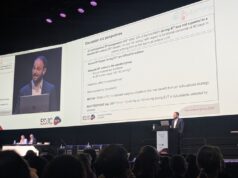
Skipping IV thrombolysis and using mechanical clot removal alone for stroke was not shown to be non-inferior compared to the combination of both treatments, but was associated with a lower risk of intracerebral haemorrhage, according to late-breaking data presented at the International Stroke Conference 2020 (ISC; 19–21 February, Los Angeles, USA).
Kentaro Suzuki of Nippon Medical School Hospital (Tokyo, Japan), presented the results of the SKIP (Randomised study of endovascular therapy with versus without intravenous tissue plasminogen activator in acute stroke with ICA and M1 occlusion) study at the conference. At 90 days, favourable outcomes, based on disability level, were similar: 59% for those who received clot removal alone and 57% for those who received the combination approach. There was no difference in death rates between the two groups. Importantly however, he acknowledged that the rates of intracerebral haemorrhage within 36 hours was significantly lower for the mechanical clot removal group than for the combination treatment group (34% vs. 50%, respectively; p=0.02).
Alluding to the purpose and rationale of the current research, Suzuki said: “As you know, the recanalisation rate of IV thrombolysis in large vessel occlusion [LVO] patients is low. As for the haemorrhagic risk, severe haemorrhagic risk of IV thrombolysis becomes three times as much [5.9% IVT vs. 1.7% for placebo].” Addressing the ISC audience, he asked: “Do you think IV tPA in LVO patients is still beneficial?”
He explained that the SKIP study was conducted to answer this very question. Further benefits of eradicating tPA, Suzuki said, include a lower haemorrhagic risk to the patients, no prohibition of antithrombotic agents, and lower costs. He added: “We may be missing reperfusion opportunities and delaying the initial therapy.”
Notably, he alluded to the fact that most patients with IVT in the HERMES collaboration included IVT ineligible patients, and subsequently highlighted the need for an RCT in eligible RCT patients.
Thus, the Japanese, multicentre, prospective, randomised trial was carried out at 23 sites and included 200 stroke patients (average age 74; 62% men) that were assigned to either mechanical clot removal alone or the combination of IV thrombolysis and mechanical clot removal.
While Suzuki pointed out that they could not prove non-inferiority of direct mechanical thrombectomy, as the frequency of favourable outcome did not differ between the two arms, he reiterated that any intracerebral haemorrhage was significantly less frequent in the direct mechanical thrombectomy group compared with those undergoing combination therapy.
However, in an American Heart Association/American Stroke Association (AHA/ASA) news release, Mitchell SV Elkind, president elect of the AHA from Columbia University, New York, USA, stated: “Current recommendations from the AHA/ASA recommend using intravenous therapy within the 4.5 hour-time window and then treating with mechanical clot removal, if appropriate.
“The best strategy is usually to treat with [alteplase] … and then if the patient is eligible, the patient goes for endovascular therapy as well,” Elkind said. “But [we] do not skip that initial step because sometimes the endovascular therapy gets delayed or does not occur for some reason or another.”
Regardless, Suzuki noted that five ongoing trials including this study are investigating the optimal approach for stroke patients.









